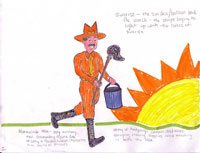[crossposted from Dale’s blog]
Dale, Marc, Laura, Melissa, and Carol Lee in attendance. We were productive as usual, although in a different way this week. I brought my worries about the calendar to the table, and we hashed that out. Part of my worries has to do with not knowing whether we have a place to perform this, and we talked about that. I know that our producing arm is working on it, but it makes me very anxious not to know.
To make a long evening short, we decided to keep working Tuesday nights (7:30 for those who would like to join us) for the rest of March, getting together our design concepts and choreographing the two staged pieces.
The first week of April is spring break, and many of us will be in New York City. And I don’t think I’ve mentioned that we will be having lunch with Nancy Willard! She’s coming down from Poughkeepsie, and we get to meet her! I’m still excited about that.
Then, starting April 10, we will meet Tuesdays and Wednesdays and begin dragging in the casts of Man in the Marmalade Hat and Two Sunflowers. Actually, on April 10, we’ll invite the members of the chorus to come and work on a little blocking/physicalization of their part of this thing.
Sometime in April, we’ll hold a weekend color-cut-and-paste session where we can build and paint stuff we need all at once.
We buckled down and got our What We Need and Who We Need done for Man in the Marmalade Hat. (Lurkers, there’s lots you can do. More than enough. Get to work.)
We realized that at some point we need to storyboard Sun & Moon Circus so we can deliberately produce visuals for the multimedia part of the concert. I also shared that I had envisaged staging “production photos” of that and other pieces for the multimedia, i.e., photo a kid tossing up a planet balloon and use that as a visual.
Carol Lee had done a different successive approximation of a sunflower, one using a glove. We’re still undecided between the glove and the crossbar on manipulating the sunflowers. She will work on those this week.
Laura wants to work on a prototype for the hedgehog costume. (Dale will start working with Laura’s mom’s kindergarten hedgehogs this week.)
Marc will work on design concepts for the Inn itself. We did decide that for May, we can get away with simple suggestions.
Dale will work on prototypes for the Toast Heads (the MMH’s marching band).
Melissa, were you working on something? I didn’t write it down.
Everyone is to work on visuals for the winter/spring motifs for the MMH’s banners.
 I had mocked up the heads of two sunflowers in the Troupe and made some leaves, so we began by attaching elastic to our feet, then to the crossbars of the flowers. We stapled the leaves to the elastic, and then we played. We played with making the sunflowers grow, making the leaves bounces. We studied how sunflowers would move, how they would jump, how they would dance. We played with one sunflower each, then two, having them relate to each other and to other sunflowers.
I had mocked up the heads of two sunflowers in the Troupe and made some leaves, so we began by attaching elastic to our feet, then to the crossbars of the flowers. We stapled the leaves to the elastic, and then we played. We played with making the sunflowers grow, making the leaves bounces. We studied how sunflowers would move, how they would jump, how they would dance. We played with one sunflower each, then two, having them relate to each other and to other sunflowers.

